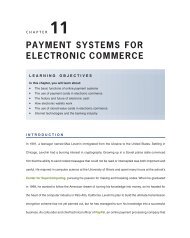ELECTRONIC COMMERCE SOFTWARE
ELECTRONIC COMMERCE SOFTWARE
ELECTRONIC COMMERCE SOFTWARE
Create successful ePaper yourself
Turn your PDF publications into a flip-book with our unique Google optimized e-Paper software.
412<br />
Chapter 9<br />
cost; other information access might require a subscription. But Web services can make<br />
automated access of the information much easier.<br />
A more advanced example would be a company that uses purchasing software to help<br />
manage that activity. That software can use Web services to obtain price information from<br />
a variety of vendors. After the purchasing agent reviews the price and delivery information<br />
and authorizes the purchase, the software can submit the order and track it until the<br />
shipment is received. On the other side of this transaction, the vendor’s software can use<br />
Web services (in addition to providing price and delivery information) to check the buyer’s<br />
credit and contract with a freight company to handle the shipment.<br />
SOAP, WSDL, and UDDI Specifications<br />
Three rule sets (usually called protocols or specifications) let programs work with the formatted<br />
(using XML or HTML) data flows to accomplish the communication that makes<br />
Web services work. The Simple Object Access Protocol (SOAP) is a message-passing protocol<br />
that defines how to send marked up data from one software application to another<br />
across a network. You can see the full SOAP specification and learn more about SOAP at the<br />
W3C SOAP Page.<br />
The characteristics of the logic units that make up specific Web services are described<br />
using the Web Services Description Language (WSDL). Today, programmers can use the<br />
information in a WSDL description to modify an application program so it can connect<br />
to a Web service. When Web services become more complex, WSDL descriptions allow programs<br />
to configure themselves to connect to multiple Web services. You can learn more<br />
about WSDL and related topics at the W3C Web Services Activity pages.<br />
Programmers (and, eventually, the programs themselves) need to find the location of<br />
Web services before they can interpret their characteristics (described in WSDL) or communicate<br />
with them (using SOAP). The set of protocols that identify locations of Web services<br />
and their associated WSDL descriptions is called the Universal Description,<br />
Discovery, and Integration (UDDI) specification. The UDDI.org Web site is a good source<br />
of information about this specification and includes the current UDDI Business Registry,<br />
which provides a catalog of currently available Web services.<br />
A number of major software vendors have embraced the idea of Web services in new<br />
technology initiatives such as Microsoft .NET and the Sun Java 2 Platform, Enterprise<br />
Edition. Many companies that have used Web services to accomplish application integration<br />
have found it to be less expensive to implement than older approaches that required<br />
programmers to write or adapt multiple middleware software programs. Merrill Lynch was<br />
able to use Web services to implement an integration project for $30,000 that would have<br />
cost $800,000 using its older application integration approach.<br />
The Future of Web Services<br />
The idea behind Web services is a major change in the way business does computing. The<br />
IT industry has historically resisted standards and has frequently used programming languages<br />
that cannot communicate with each other. For years, large businesses and other<br />
organizations have hired armies of programmers to write middleware software to integrate<br />
their hodgepodge of programs for financial management, inventory control, marketing,<br />
and other functions. The idea of connecting software within an organization is still



